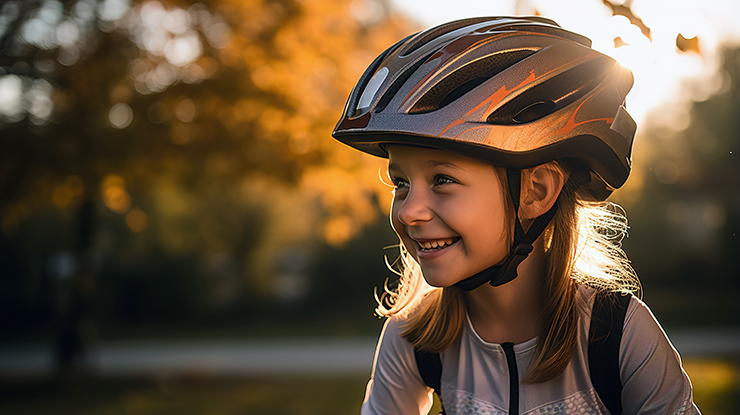Bike Safety Week
Carol Baldwin,
Local Journalism Initiative Reporter
As children pull their bicycles out of storage and get ready to ride, drivers need to use extra caution. Riding skills may be a bit rusty, and excitement is high as they reclaim the freedom that a set of wheels gives them. When motor vehicles hit children, injuries can be severe, life-changing, or fatal. Cycling is a great way to have fun and get around in one’s community, but children need parents, community leaders, and teachers to teach them and remind them of safe cycling skills. Each year in May, the Saskatchewan Prevention Institute provides thousands of educational packages to school-aged children. Community members such as teachers and first responders, work hard to distribute the materials which remind children of the actions they can take to keep themselves safe while cycling. Bicycle Safety events are an opportunity for them to learn about and practice safe cycling skills.
Each year in Saskatchewan, children are hospitalized for bicycle-related injuries, including traumatic brain injuries, the risk of which can be reduced through the use of helmets. Between 2004 and 2013, cycling was the fourth leading cause of injury-related hospitalization among children between the ages of five and nine years. Bicycle-related injuries can have devastating and sometimes life-long impacts. The Saskatchewan Prevention Institute has partnered with the Acquired Brain Injury Education & Prevention Coordinators from the Saskatchewan Health Authority to bring virtual Bicycle Safety Week presentations to classrooms across the province on May 14th, 15th, and 16th.
It is important to remember that children are not just small adults. A young child’s peripheral vision is about two-thirds of an adult’s and therefore they may not have the ability to see a car or obstacle that the adult next to them sees. They also have acute hearing but have difficulty localizing sounds which means that they have difficulty determining the direction from which a sound is coming. Children may be unaware that the sound of a vehicle they hear is moving toward them. Children are still developing physically and mentally and have many characteristics that make them vulnerable near traffic. Children lack a sense of danger. They may be impulsive, easily distracted, and impatient. They may not have the ability to process all the pieces of information necessary to make safe decisions while near traffic, despite being taught correct safety practices, and older children may participate in more risk-taking behaviours. Needing to wait for a traffic signal, being distracted by friends at the upcoming park, or misjudging the speed of an approaching vehicle in an intersection are just a few examples of how a young child may act in an unsafe manner due to their developmental stage.
The majority of bicycle-related injuries are preventable. When learning any new wheeled activity, falls are the number one cause of injury and ensuring that proper safety equipment is used will help protect children and youth. The appropriate safety equipment for cycling includes a properly fitted and approved bicycle helmet, and a properly fitted bicycle with a bell or horn reflectors, and a light on the front and rear for night riding. Children should be able to stand flatfooted over the bike with at least two centimetres of clearance above the top tube for a proper fit.
Bicycle helmets are specifically designed to absorb and dissipate the impact of a fall or collision and thereby minimize the force transmitted to the head. Head injuries are one of the most common types of injuries in bicycle accidents, and wearing a helmet can significantly reduce the risk of severe injury by up to 60 percent, but only if they are properly fitted. Poorly fitted helmets may not provide the protection they are designed to. A properly fitted helmet should sit ‘two-fingers-width’ above the eyebrows, the straps should form a ‘V’ under the ears, and one finger should be able to fit between the strap and the underside of the chin. A bicycle helmet is a single-impact item, meaning that once it has been in a hard fall, it must be replaced. For this reason, never purchase a used helmet unless from a trusted friend or family member who can vouch for the history of the helmet. Additionally, helmets should be replaced after five years as they become brittle with age and exposure to the elements.
The Canadian Safety Council reports that the majority of bicycle injuries result from falls, collisions with stationary objects, and collisions with other bikes or pedestrians. Most of these injuries happen less than five blocks away from the child’s home in familiar surroundings. Some of the most common causes of injuries and accidents are a result of driveway ride-outs where youngsters ride out of their driveway and then get hit by a vehicle; running a stop sign, turning without warning; following the leader; and riding after dark.
Learning to ride a bicycle is a complex skill. Balance, strength, and coordination are required to safely ride a bike. Children grow rapidly in spurts and because of this they often do not have an accurate awareness of their body size, abilities, and limitations; this increases a child’s risk of falling while on a bicycle.
A child’s developing motor skills also reduce their ability to avoid obstacles such as holes in the road, pedestrians, and other cyclists. A good rule of thumb is to have children who are still learning to ride, practice their skills on a soft surface away from traffic and other hazards. Children who are learning to ride should stay off busy streets, instead riding on the sidewalk to keep them safely away from traffic. While there are still safety concerns that can be encountered when riding on the sidewalk such as vehicles backing out of driveways, it is a less dangerous environment for learning to ride unless there is a bike path close by. Parents or guardians should discuss with young cyclists the approved areas for them to be riding in and the rules that go along with cycling and how to share the road, or path, or sidewalk safely with others. A bicycle is the smallest vehicle on the road, and this makes it especially important for cyclists to be visible, to ride predictably, to understand how traffic works, and to communicate with other road users.
Carol Baldwin,
Local Journalism Initiative Reporter
Wakaw Recorder




